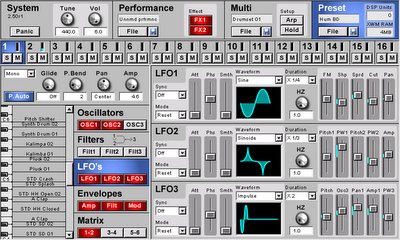Update2: Make sure to read the comments section of this post.
Update via Tom of MusicThing in the comments: "it started out as hardware:
http://musicthing.blogspot.com/2005/09/strange-story-of-keytosound-synth.html"
I forgot about that. Here's a link to the shots I pulled from the auction linked in Tom's post:
http://matrixsynth.blogspot.com/2005/09/inetsynth.htmlTitle link takes you to the INetSynth site with more info and demos. So why the INetSynth name? Apparently it has a built in browser where you can audition and grab patches instantly. Kind of interesting in that it's immediate and saves you some steps, but not quite revolutionary. I was curious if there might be more to it like some sort of online processing or the ability to collaborate with others, real time, online. But, no go. Now that would be very interesting. Hmm... Someone should come out with that. Online jam sessions, programming sessions, etc.

Details:
"KeyToSound is proud to announce the release of the INetSynth. The INetSynth is a stand-alone synthesizer or plugin supporting AU, VST, and RTAS formats on both Mac and PC.
The INetSynth runs a True Stereo® Signal Path (two signals, left and right) throughout the entire preset, starting with the oscillators, passing through modulation, filters, and effects, to the final output. The INetSynth’s true stereo signal path opens up the stereo image of the sound without reducing the number of voices or polyphony. This True-Stereo® signal path opens the doors of creativity when designing soaring leads, pads, or growling bass lines.
XWM®- Extreme Wave Memory accommodates large stereo samples by providing key-maps and individual loop points for both left and right channels. XWM technology not only produces rich and full sounds, but by handling samples efficiently, you get more performance and lower latency on playback. The INetSynth handles samples much the same way as a hardware sampler, yet gives you unlimited modulation options to create complex sounds easily.
The INetSynth is the first synthesizer ever to feature Resonance Noise Oscillators or R-Noise Oscillators®. The R-Noise Oscillator modulates a signal in a very unique way, creating a recognizable signature to the final sound. You won’t find a R-Noise Oscillator® on any other synthesizer – hardware or software!
"Multi" Oscillators are stacked Saw Tooth wave oscillators. The oscillators are layered and can be slightly detuned, producing a natural and bright timber. This is simply achieved by selecting one of the many preprogrammed “stacks” in a preset and adjusting the detune amount. This is another feature you won’t get from a hardware synthesizer!
The INetSynth has sixteen Multi-timbral layers each capable of loading a key-map with up to 128 presets making it not just a multi-timbral synthesizer, but a “Super Multi-timbral” synthesizer. That’s a Super Multi-timbral layer capable of layering 2048 presets to be triggered with one push of a key!
The INetSynth Presets are platform independent and can be auditioned and distributed online through the built in INetSynth Preset Browser. Using the NetNotes™ system, the INetSynth gives you access to presets in a way that no other synthesizer can – immediately!
Dynamic CPU Load Management - DCLM
DCLM does exactly what it says. DCLM manages the CPU load by allocating CPU resources specifically for certain components (Osc. Filter, LFO, Env., etc.) of a preset, precisely when they are needed. This ultimately enables the maximum performance from your system allowing greater polyphony of complex sounds. The more resources you have available for the INetSynth, the greater performance you get. There are no limits!
Industrial Strength Interface
Instead of being crowded with buttons and knobs that are difficult to control and view, the INetSynth’s interface is split into views which are populated by sliders, dials, and knobs in such a way that the interface is very fast and efficient to work with. Work flow for sound design and synthesizer playability are achieved by allowing quick and easy viewing of a presets layout in a well organized and structured manner.
The INetSynth can be viewed easily from a display that is 6 feet away such as behind a console or rack of keyboards and controllers. When you use INetSynth onstage, the interface and layout make it easy to read during live performances – no more squinting into a display while you should be performing!
Complete Integration
The INetSynth integrates seamlessly with all platforms and host programs. When a project using the INetSynth is saved and reloaded from any host sequencer, the INetSynth will have total recall of the presets and settings associated with that particular project. It’s all stored automatically when you save the INetSynth preset. The INetSynth is supported on both Mac and PC platforms of course. "
 Introduction
Introduction














































